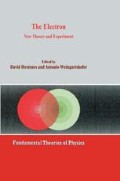Abstract
The behaviour of charged particles at electromagnetic steps is analysed using the powerful mathematical tools provided by the SpaceTime Algebra. Currents predicted in the evanescent region of a Dirac wavefunction strongly suggest that the electron “zitterbewegung” (ZBW) represents a real circulation. At higher potentials, the Klein paradox reveals a crucial difficulty of interpretation of “positronic” wavefunctions that must be overcome before Hestenes’ ZBW model can be taken seriously. The problem of radiation reaction is still not solved. Solutions of the Lorentz-Dirac equation for a potential step show crazy teleological features: certain input velocities have no possible future output states. The prospects for realistic electron models are briefly discussed.
Access this chapter
Tax calculation will be finalised at checkout
Purchases are for personal use only
Preview
Unable to display preview. Download preview PDF.
References
Abers, E. & Lee, B. (1973). Gauge Theories. Phys. Reports, 9, 1–141.
Barut, A. O. (1988). Lorentz-Dirac Equation and Energy Conservation for Radiating Electrons. Phys. Lett., 131, 11–12.
Barut, A. O. (1990). Renormalisation and Elimination of Preacceleration and Runaway Solutions of the Lorentz-Dirac Equation. Phys. Lett., A131, 11–12.
Barut, A. O. & Zhanghi, N. (1984). Classical Model of the Electron. Phys. Rev. Lett., 52, 2009–2012.
Bjorken, J. D. & Drell, S. D. (1964). Relativistic Quantum Mechanics, Vol. 1. McGraw-Hill, New York.
Burke, W. L. (1970). Runaway Solutions: Remarks on the Asymptotic Theory of Radiation Damping. Phys. Rev., A2, 1501–1505.
Dirac, P. A. M. (1938). Classical Theory of Radiating Electrons. Proc. Roy. Soc. Lond., A47, 148–169.
Feynman, R. P. (1967). The Character of Physical Law. MIT Press, Cambridge MA.
Grandy, W. T., Jr. & Aghazadeh, A. (1983). Radiative Corrections for Extended Charged Particles in Classical Electrodynamics. Ann. Phys., 142, 284–298.
Hestenes, D. (1966). Space-Time Algebra. Gordon & Breach, New York.
Hestenes, D. (1979). Spin and Uncertainty in the Interpretation of Quantum Mechanics. Am. J. Phys., 47, 399–415.
Hestenes, D. (1982). Space-Time Structure of Weak and Electromagnetic Interactions. Found. Phys., 12, 153–168.
Hestenes, D. (1986). A Unified Language for Mathematics and Physics. In Clifford Algebras and Their Application in Physics, (ed. J. S. R. Chisholm & A. K. Common), pp. 1–23. D. Reidel, Dordrecht.
Hestenes, D. (1990). The Zitterbewegung Interpretation of Quantum Mechanics. Found. Phys., 20, 1213–1232.
Jaynes, E. T. (1990). Probability in Quantum Theory. In Complexity, Entropy, and the Physics of Information, (ed. W. H. Zurek), pp. 33–55. Addison-Wesley, Redwood City CA.
Nikishov, A. I. (1970). Barrier Scattering in Field Theory and Removal of the Klein Paradox. Nuclear Phys.,B21, 346–358.
Sawada, T., Kawabata, T. &; Uchiyama, F. (1983). Derivation of an extra condition on the Lorentz-Dirac equation from a conservation law. Phys. Rev., D27, 454–455.
Wheeler, J. A. & Feynman, R. P. (1949). Classical Electrodynamics is Terms of Direct Interparticle Action. Rev. Mod. Phys., 21, 425–433.
Author information
Authors and Affiliations
Editor information
Editors and Affiliations
Rights and permissions
Copyright information
© 1991 Kluwer Academic Publishers
About this chapter
Cite this chapter
Gull, S.F. (1991). Charged Particles at Potential Steps. In: Hestenes, D., Weingartshofer, A. (eds) The Electron. Fundamental Theories of Physics, vol 45. Springer, Dordrecht. https://doi.org/10.1007/978-94-011-3570-2_3
Download citation
DOI: https://doi.org/10.1007/978-94-011-3570-2_3
Publisher Name: Springer, Dordrecht
Print ISBN: 978-94-010-5582-6
Online ISBN: 978-94-011-3570-2
eBook Packages: Springer Book Archive

